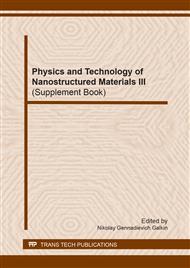[1]
G. Palumbo, K.T. Aust, A coincident axial direction (CAD) approach to the structure of triple junctions in polycrystalline materials, Scripta Metallurgica et Materialia. 24 (1990) 1771-1776.
DOI: 10.1016/0956-716x(90)90544-q
Google Scholar
[2]
S.G. Protasova, V.G. Sursaeva, L.S. Shvindlerman, Study of the motion of individual triple junctions in aluminum, Physics of the Solid State. 45 (2003) 1471-1474.
DOI: 10.1134/1.1602881
Google Scholar
[3]
P. Rodriguez, D. Sundararaman, R. Divakar, V.S. Raghunathan, Structure of grain boundaries in nanocrystalline and quasicrystalline materials, Chemistry for Sustainable Development. 8 (2000) 69-72.
Google Scholar
[4]
T. Frolov, Y. Mishin, Molecular dynamics modeling of self-diffusion along a triple junction, Physical Review B. 79 (2009) 174110 (5).
DOI: 10.1103/physrevb.79.174110
Google Scholar
[5]
A.G. Lipnitskii, I.V. Nelasov, Yu.R. Kolobov, Self-diffusion parameters of grain boundaries and triple junctions in nanocrystalline materials, Defect and Diffusion Forum. 309-310 (2011) 45-50.
DOI: 10.4028/www.scientific.net/ddf.309-310.45
Google Scholar
[6]
G.M. Poletaev, D.V. Dmitrienko, V.V. Diabdenkov, V.R. Mikrukov, M.D. Starostenkov, Molecular dynamics investigation of the diffusion permeability of triple junctions of tilt and mixed-type boundaries in nickel, Physics of the Solid State. 55 (2013).
DOI: 10.1134/s1063783413090254
Google Scholar
[7]
N.A. Koneva, E.V. Kozlov, N.A. Popova, A.N. Zhdanov, M.V. Fedorischeva, Structure of triple junctions of grains, nanoparticles in them and bending-torsion in metal nanopolycrystals, Materials Science Forum. 584-586 (2008) 269-274.
DOI: 10.4028/www.scientific.net/msf.584-586.269
Google Scholar
[8]
G.M. Poletaev, A.B. Yuriev, V.E. Gromov, M.D. Starostenkov, Atomic mechanisms of the structure-energetical transformations near tilt grain boundaries in fcc metals and Ni3Al intermetallide, SibSIU, Novokuznetsk, 2008. (in Russian).
Google Scholar
[9]
F. Cleri, V. Rosato, Tight-binding potentials for transition metals and alloys, Physical Review B. 48 (1993) 22-33.
DOI: 10.1103/physrevb.48.22
Google Scholar
[10]
G.M. Poletaev, M.D. Starostenkov, Contributions of different mechanisms of self-diffusion in face-centered cubic metals under equilibrium conditions, Physics of the Solid State. 52 (2010) 1146-1154.
DOI: 10.1134/s1063783410060065
Google Scholar
[11]
G.M. Poletaev, M.D. Starostenkov, Dynamic collective displacements of atoms in metals and their role in the vacancy mechanism of diffusion, Physics of the Solid State. 51 (2009) 727-732.
DOI: 10.1134/s106378340904012x
Google Scholar
[12]
G.M. Poletaev, D.V. Dmitrienko, V.V. Diabdenkov, A.V. Sannikov, M.D. Starostenkov, A.A. Sitnikov, Molecular dynamics study of conditions of formation of non-disclination triple junctions of grain boundaries in metals, Fundamentalnye problemy sovremennogo materialovedenia. 10 (2013).
Google Scholar


